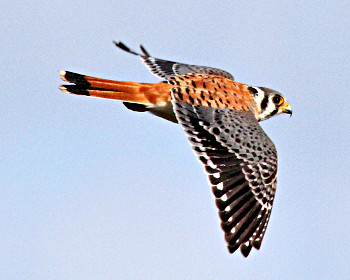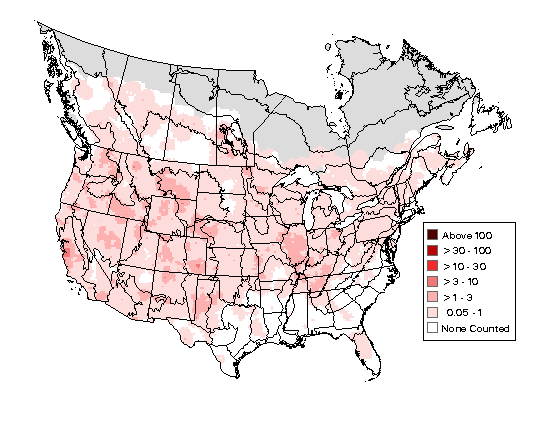American Kestrel

American Kestrel Information
Length: 9 - 12"
Habitat: Open and semi-open habitat including farmland, forest openings, marshes, and residential areas. Prefers habitat which has trees with existing nesting cavities. Requires high perches from which to hunt.
Diet: Insects, including grasshoppers, dragonflies, beetles, and caterpillars; small mammals such as voles and mice; small birds, frogs, lizards, small snakes.
Interesting Facts about the American Kestrel
- The American Kestrel is the smallest North American falcon, being only 9-12 inches in length.
- This raptor is found in open or semi-open habitats, preferring areas which have trees with natural cavities for nesting.
- It is believed that American Kestrels mate for life. However, due to the stricter than usual division of labor, the male and female spend very little time together, even during breeding season.
During this period, the male spends most of his time hunting for food for himself and his mate. The female spends most of her time either on or near the nest, although the male does relieve the female from incubation for part of each day.
- Kestrels in southern areas are often permanent residents. However, the more northern birds generally migrate further south for the winter. The peak migration period is mid-September through early October.
American Kestrel

American Kestrel
Identification Tips
- Wingspan: 21 inches
- Short, dark, hooked beak
- Small, long-tailed hawk
- Long, narrow, pointed wings
- Gray crown
- White cheeks
- Two black mustache marks
- Black spot at rear of crown on both sides
- Seen from below, flight feathers are pale with dark barring
- Juveniles and immature females like adult female
Adult Male
- Rust patch on crown
- Rust nape, breast, back and tail
- Rust tail has a broad black subterminal band and a narrow white terminal band
- Pale belly
- Blue-gray wing coverts
- Dark flight feathers with pale subterminal spots creating a "string of pearls"
- Black spots on scapulars, wing coverts and flanks
Adult Female
- Pale buff breast streaked with brown
- Rust-brown nape, back and wing coverts
- Back and wing coverts barred heavily with black
- Rust-brown tail with numerous dark bars of even width and a narrow white terminal band
(Credit: U. S. Geological Survey)
American Kestrel
Breeding Bird Survey Map,
2011-2015

(Image credit: USGS)
American Kestrel
Range Maps from Cornell
American Kestrel breeding, nonbreeding and year-round range
Includes separate map of sightings.
American Kestrel
Christmas Bird Count Map
Historical CBC Map from USGS